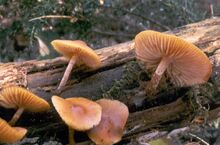Psilocybe subaeruginosa

Hunting psychoactive mushrooms in nature can be very dangerous.
Caution is advised because poisonous or deadly mushrooms can easily be mistaken for edible ones.
| Psilocybe subaeruginosa | |
|---|---|
|
P. suberuginosa growing under a potplant. |
|
| Taxonomical nomenclature | |
| Kingdom | Fungi |
| Phylum | Basidiomycota |
| Class | Agaricomycetes |
| Order | Agaricales |
| Family | Hymenogastraceae |
| Genus | Psilocybe |
| Species | P. subaeruginosa |
| Common nomenclature | |
| Common names | Wavy caps, Subs, Gold Tops |
| Mycological Characteristics | |
| Spore print | Purple-black |
| Edibility | Psychoactive |
| Constituents | |
| Active constituents | Psilocin, Psilocybin |
Psilocybe subaeruginosa is a potent psychedelic mushroom in the Psilocybe genus.
Habitat and distribution
Psilocybe subaeruginosa is native to Australia and New Zealand, and grows on woody substrates and tends to be found in woodchipped garden beds or in pine and eucalypt forests among fallen debris.
In Australia, P. subaeruginosa occurs in the south eastern part of the continent including Victoria and parts of South Australia and New South Wales. It also occurs across Tasmania and near the Balingup region of Western Australia.
In New Zealand, P. subaeruginosa occurs across the North Island and the northern 2/3rds of the South Island.
Fruiting is dependent on a drop in temperature, increased moisture levels, and a shortening of the day/night light cycle. The fruiting season typically starts when cold wet weather arrives in April and ends in August, but will vary according to regional conditions.
P. subaeruginosa has been spread artificially to some locations in North America.
Cultivation
P. subaeruginosa mycelium is relatively straightforward to cultivate but artificially inducing fruiting can be somewhat challenging. Most subaeruginosa cultivation involves tending to colonies among one's garden beds or pot plants and relying upon natural conditions to bring about a seasonal harvest.
Potency
As with all woodloving psilocybes, P. subaeruginosa tends to be more potent than typical Psilocybe cubensis, with some patches producing specimens of breathtaking potency, this should be taken into account when dosing.
Similar species
Galerina marginata
Galerina marginata mushrooms are an extremely dangerous species which contain the same deadly amatoxins found in the death cap. They have similar habits and appearances, and the two mushrooms bear such a superficial resemblance to each other that new mushroom-seekers may confuse the two. The two species can grow side by side, which may add to the chance of confusion. This mushroom can cause death and severe liver damage as well as vomitting, diarrhea, and hypothermia if not quickly treated.
The size is roughly the same and the typical darkening at the base of the stem of Galerina species can be mistaken for the bluing reaction of Psilocybes. The spore colors are similar. Psilocybe species yield a purplish brown spore print versus the redder brown of a Galerina.

